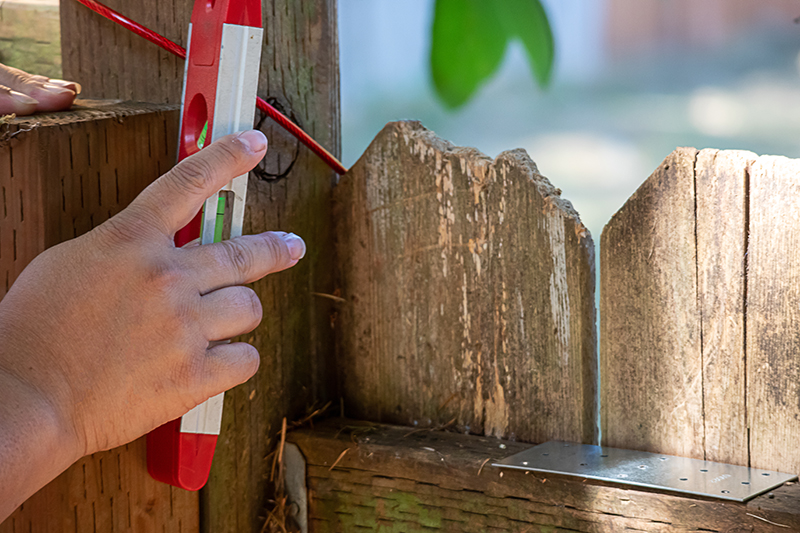
Repairing or Replacing Your Fence After Hurricane Beryl: Making the Right Choice
The aftermath of Hurricane Beryl in the Greater Houston Area has left many homeowners facing decisions about repairing or replacing their fences. With missing pickets and sections of fences fallen down, the dilemma arises: should you repair the damage or opt for a complete replacement? Here’s a guide to help you make an informed decision, considering both practical and safety factors.
Assessing the Damage
The first step after any storm damage is to assess the extent of the damage to your fence. Look for missing pickets, leaning sections, and overall structural integrity issues. Sometimes, apparent minor damage can hide deeper issues that affect the stability of the entire fence.
Repairing Your Fence
Repairing the fence may be a viable option if:
-
Localized Damage: Only a few pickets are missing or a small section is leaning. In such cases, repairing those specific areas can restore the functionality and appearance of your fence.
-
Structural Integrity: The fence posts and rails are still sturdy and the damage is mainly cosmetic. Repairing or replacing individual components can often suffice to restore the fence.
-
Budget Considerations: Repairing a fence is generally less expensive than replacing it entirely. This can be crucial, especially when dealing with other storm-related repairs.
Replacing Your Fence
Consider replacing your fence if:
-
Extensive Damage: Large sections of the fence are down or the entire structure is compromised. In such cases, replacing the entire fence might be safer and more cost-effective in the long run.
-
Older Fences: If your fence was nearing the end of its lifespan or had existing issues before the storm, replacing it could provide a longer-term solution with less maintenance.
Discussing Cost Sharing with Your Neighbor
When considering repairing or replacing your fence, it’s important to discuss the costs with your neighbors if the fence is shared. Open communication about sharing the financial responsibility can prevent misunderstandings and ensure a cooperative effort in restoring the property boundaries. Sharing costs fairly can also help maintain good neighborly relations and expedite the repair or replacement process, benefiting both parties in the long term.
Ensuring HOA Compliance
Before embarking on any fence repair or replacement project post-Hurricane Beryl, homeowners should ensure their plans align with their Homeowners Association (HOA) guidelines. Many neighborhoods require an Architectural Control Committee (ACC) submittal for review before any construction begins.
Consulting these guidelines beforehand is crucial to avoid potential fines or disputes. The ACC review ensures that the fence design meets community standards and aesthetic requirements, ensuring harmony within the neighborhood while also maintaining property values. By adhering to HOA regulations, homeowners can proceed confidently with their fence restoration project.
Calling 811 Before You Dig
If you decide that replacing your fence is necessary, it’s crucial to call 811 before starting any digging for new post holes. Here’s why it’s important:
-
Safety Precaution: Calling 811 allows utility companies to mark the locations of underground utilities such as gas lines, water pipes, and electrical cables. Accidentally hitting these lines during excavation can pose serious safety hazards and lead to costly repairs.
-
Legal Requirement: In many areas, it’s a legal requirement to contact 811 before digging deeper than a certain depth. This ensures compliance with local regulations and helps prevent fines or penalties.
-
Avoiding Disruptions: Damaging underground utilities can cause disruptions not only to your property but also to neighboring properties. It’s essential to avoid such disruptions, especially during the post-hurricane recovery phase.
How to Contact 811
-
Plan Ahead: Contact 811 at least a few days before you plan to start digging. This gives utility companies enough time to mark the approximate locations of their lines. Visit call811.com/811-In-Your-State/Map/State/Texas for information.
-
Provide Details: When contacting 811, be ready to provide specific information about your digging project, including the address and the extent of the work.
-
Respect the Markings: Once utility lines are marked, take care to dig carefully around these markings. Hand digging near marked lines may be necessary to avoid damage.
Navigating the decision to repair or replace your fence after Hurricane Beryl involves careful consideration of the extent of the damage, your budget, and safety precautions. Whether you choose to repair or replace, ensuring you call 811 before digging is a crucial step to protect yourself, your property, and your community from potential hazards and disruptions. By taking these steps, you can effectively restore your property’s security and aesthetics while ensuring safety during the recovery process.
 Tiffany Krenek has been on the My Neighborhood News team since August 2021. She is passionate about curating and sharing content that enriches the lives of our readers in a personal, meaningful way. A loving mother and wife, Tiffany and her family live in the West Houston/Cypress region.
Tiffany Krenek has been on the My Neighborhood News team since August 2021. She is passionate about curating and sharing content that enriches the lives of our readers in a personal, meaningful way. A loving mother and wife, Tiffany and her family live in the West Houston/Cypress region.





